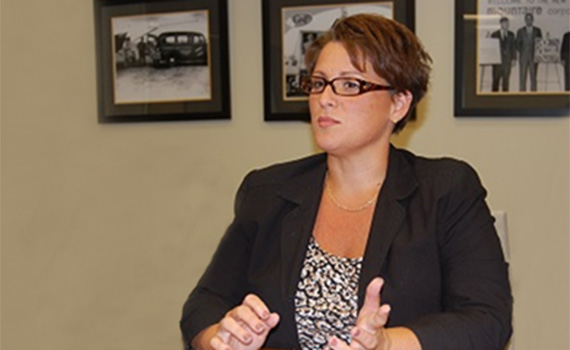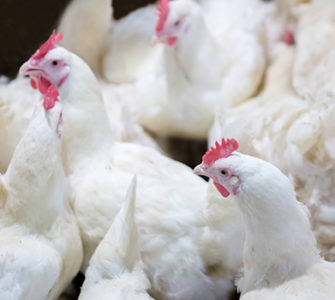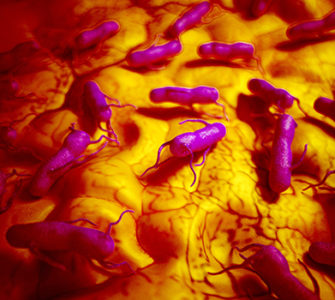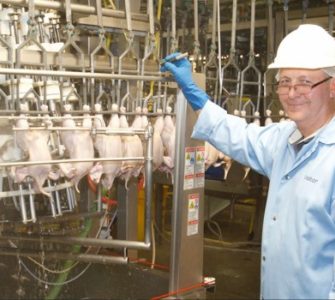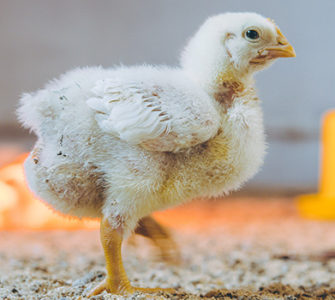Incentives missing in New Poultry Inspection System, says NCC’s Peterson
By Gary Thornton
The ability to forgo the SIP waiver process for on-line processing may be the rule’s biggest benefit for the poultry industry, said the National Chicken Council’s Vice President of Science and Technology Ashley Peterson.
WATT PoultryUSA: In terms of food safety, does the New Poultry Inspection System (NPIS) move the needle forward?
Dr. Ashley Peterson: It is difficult to say. With the increase in testing requirements and an increase in food safety related tasks performed by USDA Food Safety and Inspection Service (FSIS) inspectors, it is possible that this could help improve food safety. However, until attribution models used by the various agencies are corrected, the chicken industry remains a focal point for both FSIS and the Centers for Disease Control (CDC), though if you look at the industry’s Salmonella and Campylobacter performance over the past five to ten years, we have made significant progress.
What we do know is that plants participating in the HACCP Inspection Models Project (HIMP) pilot for the past 15 years have as good or better food safety records than plants with traditional inspection.
WATT PoultryUSA: From the poultry processors’ point of view what are the wins and losses in the rule’s final provisions?
Peterson: The most significant item that was in the proposed rule but not in the final rule is line speed. Line speed for chicken processing was capped in the final rule at 140 birds per minute (bpm) – the same speed the industry can operate at currently. Any advancement in food safety that will improve and protect public health is a win. It is beneficial to the industry that it will no longer have to go through the Salmonella Initiative Protocol (SIP) waiver process in order to use on-line reprocessing and various other in-plant activities that used to require a SIP waiver.
WATT PoultryUSA: What are the incentives for poultry processors to participate in the New Poultry Inspection System?
Peterson: We are still in the process of reviewing the contents of the final rule, so it is too early right now to determine what the incentives are and if and how many plants will opt in.
WATT PoultryUSA: What provisions in this new rule are likely to be the biggest challenge for processors going forward?
Peterson: I believe the industry will adjust into NPIS with minimal challenges. The industry is already performing a significant amount of in-plant testing for pathogens. Notice 37-14 (Procedures for Notifying the Occupational Safety and Health Administration (OSHA)) that was published several days after NPIS was finalized may provide some challenges to the industry. It is hopeful that this tool will be used as intended and not abused.
WATT PoultryUSA: Why is the New Poultry Inspection System voluntary for processors? Is this something upon which the National Chicken Council or others in the industry took a position during the comment period for the regulation?
Line speed for chicken processing was capped in the final rule at 140 birds per minute – the same speed the industry can operate at currently. –Ashley Peterson, NCC
Peterson: The National Chicken Council did not ask for this rule to be voluntary during the comment period. There are many establishments that want to operate at lower line speeds than 140 bpm and they should be allowed to do so and not forced into a new inspection system. Fortunately the final rule allows for that flexibility. There are parts of the final rule that are mandatory for all establishments whether they opt into NPIS or not.
WATT PoultryUSA: Would you anticipate that a significant number of processing plants will adopt the New Poultry Inspection System? Why or why not?
Peterson: We do not expect that a significant number of processing plants will adopt NPIS. There is very little incentive to do so.
WATT PoultryUSA: There are several different FSIS inspection schemes under which processing plants are currently operating. How might that change going forward?
Peterson: In the final rule, the current FSIS inspection schemes remain fully functional. The final rule essentially adopts a new inspection scheme that the industry can use if it chooses. I do not see that changing in the near future, however.
WATT PoultryUSA: Sixty-eight members of Congress sent a letter in March to Agriculture Secretary Tom Vilsack asking that the rule be withdrawn because they felt it would undermine the agency’s “food safety and humane slaughter practices” in part because it would have plant employees performing some tasks formerly performed by FSIS inspectors. Is this opposition founded primarily on members of Congress responding to their political constituencies’ interests or is it due to a misunderstanding or disagreement about the rule’s true impact?
Peterson: It is both. We have 15 years of data from 20 chicken plants where food safety, worker safety and humane slaughter practices have not been undermined.
The chicken industry remains one of the most heavily regulated industries in the United States. It is the law that FSIS must inspect each and every bird processed in a chicken establishment, and that absolutely does not change in the new rule. Under NPIS, USDA remains in its oversight role and USDA inspectors will still be in every plant, looking at each bird to ensure the safety of chicken products and providing them with the USDA seal of approval for wholesomeness. The proportion of FSIS inspectors doing critical food safety-related tasks will actually increase, not decrease as some of the critics may say.
Specifically, a USDA poultry inspector will be stationed further down the evisceration line and just before the chiller to ensure that birds have been properly processed. The facility will now be in charge of its own quality assurance program by training sorters to remove any quality defects from carcasses thereby allowing FSIS inspectors to focus more on food safety-related parameters and not visible defects.
WATT PoultryUSA: Would you say that the poultry inspector’s union and activist groups were successful in their attempts to make worker safety and health a major issue in the rule’s final formation?
Peterson: Plain and simple, politics got in the way of sound science. We have a pilot project that has proven over the years to be safe and effective for all involved, yet, in an attempt to save a few federal union jobs that have proven unnecessary over the past 15 years, the inspectors union and their allies have spread many misconceptions about this inspection system and chicken processing in general.
In the final rule, the current FSIS inspection schemes remain fully-functional. –Ashley Peterson, NCC
WATT PoultryUSA: One activist said the lessons learned by activists, as they worked on influencing the making of the rule, were as follows: “Focus on quantifiable issues, focus on moving forward and not backward, persevere and push hard on important issues but avoid the minutia, and never give up.” Is there anything that processors can learn from this rule-making?
Peterson: One thing that we have learned is that politics can trump sound science. The activists focused on the emotion around the issue – worker safety, animal welfare, etc. – and not the science. If they really focused on quantifiable issues, they, too, would have seen what the data has been telling the industry for years. The data clearly shows that in HIMP plants, worker safety and food safety is as good as if not better than traditional inspection.
WATT PoultryUSA: What do you anticipate will be the next issues or challenges faced by processors (regulatory-wise or otherwise) as a result of this rule?
Peterson: Since the rule is voluntary it is difficult to tell how many establishments will opt into NPIS. With that said, understanding how the rule impacts the chicken industry and each individual establishment will be the next challenge. Large chicken establishments have 90 days from the publication of the final rule [published August 21] to implement the mandatory testing changes.
WATT PoultryUSA: The poultry parts food safety performance standard is expected to be proposed at any time. What insight can you give us about the likely timing and provisions?
Peterson: FSIS will be establishing a chicken parts performance standard in the near future and we expect to have more details from FSIS on what that performance standard will look like this fall. It is likely that the performance standard will be below 12 percent, which will represent less than half of the baseline for chicken parts. One concern that the industry has had is that the various parts of the chicken (wing, leg, thigh, etc.) can have various microbial profiles. However, we understand that FSIS will be publishing one performance standard for all chicken parts instead of distinguishing between the parts themselves.
WATT PoultryUSA: What are the food safety performance trends for whole birds and poultry parts today?
Peterson: According to the last USDA Food Safety and Inspection Service (FSIS) Quarterly Progress Report which included data from October through December 2013, only 1.0 percent of young chicken carcasses tested positive for Salmonella in large chicken establishments. Large establishments represented almost 63 percent of all testing FSIS performed on young chicken carcasses. This 1.0 percent is a mere fraction of the FSIS performance standard of 7.5 percent. Comparing the same data from 2012, the industry was at 2.2 percent.
The only information available on chicken parts is in the chicken parts baseline results that were published the spring of 2013.
WATT PoultryUSA: What are the issues upon which NCC and the industry are focused concerning the food safety of poultry parts – both from a regulatory standpoint and voluntarily in terms of industry practices?
Peterson: From a regulatory standpoint, we remain concerned that there will be one performance standard for all chicken parts when we know from the chicken parts baseline results published by FSIS that all parts are not created equal. We are also concerned that the baseline was conducted over a six-month period instead of a year. Finally, we remain concerned as to what the final performance standard might be for chicken parts and how the industry will achieve the desired reduction.
The industry is collaboratively working together to determine what technologies work best to reduce pathogens on poultry parts.
One of the biggest challenges is the complexity of second processing – where whole birds are cut into parts. –Ashley Peterson, NCC
WATT PoultryUSA: What are the biggest challenges involved with reducing pathogens in poultry parts?
Peterson: One of the biggest challenges is the complexity of second processing – where whole birds are cut into parts. First processing is a very streamlined system, and the industry has demonstrated through our whole bird Salmonella and Campylobacter performance that we are doing a great job. Second processing is certainly not as streamlined and is variable between all establishments – even within the same company. This provides the industry with a challenge when we look at reducing pathogens. With that said, the industry has been looking at a variety of interventions, engineering changes and technologies to reduce pathogens, but all with various results. Just like in any other segment of chicken processing, there is no silver bullet to get rid of all pathogens, but the industry is working together to determine what processes work and how they are best applied and utilized so that when the standard comes out, we will be meeting and exceeding it as we currently do for whole birds.
WATT PoultryUSA: What new practices or technologies are under trial or already coming into use that may make a positive difference in the food safety of poultry parts?
Peterson: There are a variety of antimicrobials, application methods and technologies that are being trialed across the industry. We have certainly learned a lot as an industry over the past two years regarding chicken parts, including duration, concentration and mode of application of various antimicrobials and identifying potential sites for cross contamination.
WATT PoultryUSA: What kind of regulatory framework or provisions, specifically, would best enhance food safety of poultry parts?
Peterson: Eliminating bacteria entirely is always the goal. But in reality, it’s simply not feasible. No legislation, regulation or petition can keep bacteria from existing. What will make Salmonella disappear is science, research and breaking the chain of Salmonella at every stage of poultry production from the breeder farm to the processing plant. Coupled with proper handling and cooking to 165 F, chicken is safe to eat 100 percent of the time.
WATT PoultryUSA: What other important food safety issues are on the horizon?
Peterson: Recently, FSIS denied the Center for Science in the Public Interest (CSPI) petition that was calling for the Agency to declare four strains of antibiotic-resistant Salmonella as adulterants in raw ground meat and poultry products. Declaring any Salmonella as an “adulterant” does not make Salmonella go away. The industry continues to drive down Salmonella on raw ground chicken. In addition, the industry supports the responsible and judicious use of FDA-approved antibiotics and the involvement of veterinarians in raising healthy chickens. We support FDA’s Guidance 213 which implements a plan to phase out over a three-year period the sub-therapeutic use of medically important antibiotics in food producing animals. We also support FDA’s proposed Veterinary Feed Directive (VFD), which will ensure that all antibiotics that are administered to food producing animals will be done so under the supervision of a veterinarian.
Additionally, FSIS will be establishing a chicken parts performance standard in the near future, and we expect to have more details from FSIS on what that performance standard will look like this fall.
Finally, FSIS continues to sample comminuted chicken, and we expect that the Agency will follow the same process they have been using with regards to chicken parts where they published a baseline a little over a year after the sampling began. So we should expect to see a baseline for comminuted this fall, as well.
Article courtesy of WATT PoultryUSA.
Posted on February 26, 2014



